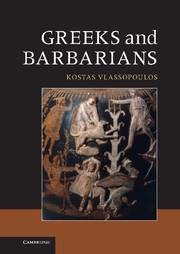Book contents
- Frontmatter
- Contents
- List of Maps and figures
- Acknowledgements
- Note to the reader
- List of Abbreviations
- 1 Introduction
- 2 The Panhellenic world and the world of empires
- 3 The world of networks and the world of apoikiai
- 4 Intercultural communication
- 5 The Barbarian repertoire in Greek culture
- 6 Globalisation and glocalisation
- 7 The Hellenistic world
- 8 Conclusions
- Bibliography
- Index locorum
- Index
5 - The Barbarian repertoire in Greek culture
Published online by Cambridge University Press: 05 June 2013
- Frontmatter
- Contents
- List of Maps and figures
- Acknowledgements
- Note to the reader
- List of Abbreviations
- 1 Introduction
- 2 The Panhellenic world and the world of empires
- 3 The world of networks and the world of apoikiai
- 4 Intercultural communication
- 5 The Barbarian repertoire in Greek culture
- 6 Globalisation and glocalisation
- 7 The Hellenistic world
- 8 Conclusions
- Bibliography
- Index locorum
- Index
Summary
It is time to examine the second of the paradoxes we set out in the Introduction: the paradoxical nature of Greek participation in the processes of globalisation and glocalisation and their effects on Greek culture. Chapter 4 examined in detail the contexts, patterns and content of intercultural communication in the ancient Mediterranean. Intercultural communication involved practices, ideas and stories which were transmitted across cultures. A series of texts translated and recorded in the Hittite language of the second millennium are known as the Kumarbi cycle and deal with the topic of divine succession in heaven. The myths describe how the deity Anu is confronted by his cup-bearer Kumarbi and flees to heaven, but has his genitals bitten off and swallowed by Kumarbi. Kumarbi becomes divine ruler, but has three fearful deities inside his body as a result of swallowing Anu’s genitals. His attempt to prevent them from coming out fails after swallowing a rock, and the weather god Teshub emerges out of Kumarbi’s body and eventually succeeds him as ruler. It is obvious that a version of this myth has been transmitted through intercultural communication and further adapted in the succession myth narrated in Hesiod’s Theogony, where Cronus castrates Uranus, swallows his children and is finally defeated by his son, the weather god Zeus.
The interaction with the Persian Empire that we examined in Chapter 2 had obvious effects on Athenian culture. Through trade, gift-exchange and war spoils, Athenian potters came across metal vase forms popular in Persia, such as the handless vases in the form of an animal head, adopted the shape in clay, but adapted it to suit Greek drinking customs by adding handles and a foot. Another example is that of the parasol, a traditional status symbol for Near Eastern kings, who were often depicted served by parasol bearers in Assyrian or Persian art, which in the course of the first millennium was also adopted by the aristocracies of Asia Minor as a status symbol.
- Type
- Chapter
- Information
- Greeks and Barbarians , pp. 161 - 225Publisher: Cambridge University PressPrint publication year: 2013

